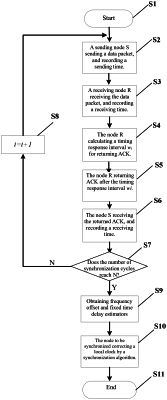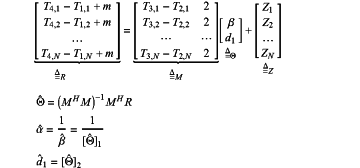| CPC H04L 5/0055 (2013.01) [H04J 3/06 (2013.01); H04L 1/16 (2013.01)] | 2 Claims |

|
1. A method for estimating clock frequency offsets of industrial wireless sensor networks based on timing response, characterized in that: in a wireless sensor network, when an arbitrary node S to be synchronized in the network need to realize synchronization with a reference node R, two-way communication between the nodes is carried out in a communication mode of one-way data packet+ACK, and estimation of time synchronization parameters does not depend on timestamp information; because no timestamp exchange is required, synchronization function can be embedded into an existing data exchange process; after a data packet message sent by a sending node S is received by the reference node R, two or more different values of a timing response interval are obtained according to a sequence number (Seq) of a received data packet by adopting corresponding rules; and the method specifically comprises the following steps:
S1: estimation of a clock frequency offset is performed along with data packet sending and receiving of the nodes, assuming that the node S to be synchronized sends a data packet to the reference node R at a local time T1,i(S), and records the sending time T1,i(S);
S2: as crystal oscillators of the node R and the node S have different frequencies, if fR represents a crystal oscillator frequency of the node R, and fs represents a crystal oscillator frequency of the node S, the reference node R records a local time T2,i(R) when receiving a data frame sent by the node S; as influenced by a fixed delay d1 during data packet transmission and a random delay X1 in an uplink, it can be obtained that
T2,i(R)=α×T1,i(S)+θt0+α×(d1+xi)
wherein
 represents a clock frequency offset of the node S relative to the node R, θt0 represents an initial phase offset between the nodes, Xi represents an independent and identically distributed Gaussian variable, and d1 represents the fixed delay during data packet transmission;
the node R returning an ACK message to the node S to be synchronized after a timing response interval wi, and records a local time T3,i(R) when the ACK message is returned, wherein the interval wi is obtained according to the sequence number of the data packet received by the node R in each cycle and the corresponding rules for timing response;
S3: the node S to be synchronized records a local time T4,i(S) when receiving a response message from the reference node R; assuming that a fixed delay d2 during transmission of an ACK data packet is equal to the fixed time delay d1 during data packet transmission minus a constant value m, wherein, d2=d1−m; similarly, with the influence of the fixed time delay d2 during transmission and a random delay y in a downlink, the following timestamp relational expression is obtained:
T3,i(R)=α×T4,i(S)+θt0−α×(d2+Yi)
wherein Y1 is an independent and identically distributed Gaussian variable;
S4: repeating the above steps S1-S3; if
 and a matrix is used to store the timestamps T1,i(S), T2,i(R), T3,i(R), T4,i(S) and different timing response intervals wi of the node R, then clock synchronization parameters, i.e., the clock frequency offset α and the fixed time delay d1 during data packet transmission, can be estimated after N cycles, and the formulas are as follows:
 wherein α is a clock frequency offset estimator, d1 is a fixed delay estimator during data packet transmission, and Zi=Xi+Yi is the independent and identically distributed \ Gaussian variable, i.e., Zi:N(0, σ2).
|